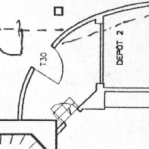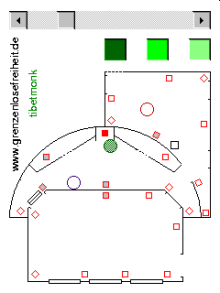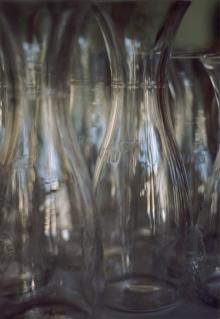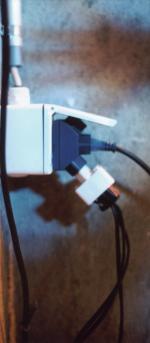 |
 |
 |
 |
 |
|
philosophy
|
|
|
 |
 |
the interactive sound installation »grenzenlose freiheit« aims at being a performance, an instrument, a game, all at the same
time. being as simple and instantaneous as a game, the seriousness of
playing an instrument gets combined with the amusement of a
performance event.
the german term »grenzenlose freiheit« means something like "boundless freedom" - and hints at an
utopian untertaking. the work is inscribed into three contiguous but different rooms. the presentation of the sound installation is delegated to the
audience: three wirelessly connected handheld computers are used to
collectively control the installation by three visitors at the a
time.
in »grenzenlose freiheit« concrete sounds with an urban origin are used to produce unsteady
sound textures in realtime. virtuality gets interspersed by reality, spaces undergo alienation,
social situations are confronted with the massive presence of
technology.
|
|
philosophy
space
locomotion
time
privacy
power
|
 |

|
|
space
|
|
|
 |
|
the sound installation »grenzenlose freiheit« is physically present in an artificial space by inscribing it into
three contiguous rooms, differing as much as possible in their
acoustical, visual and atmospherical qualities. these external qualities are emphasized by the installation,
abstracting from the original purpose of the rooms and thus recreating
them as an artificial space.
this alienation is enforced by reflecting the artificial space in a
virtual space: the user interface provided by the handheld computers,
which show a floor plan of the three rooms, the position of 24
loudspeakers and three sound items together with some control
elements.
using one end of an ordinary q-tip® first to clean the visitor's
ears and then the other (sic!) end as the stylus for the
touch-sensitive screen of the handheld computer, the sound item may be
dragged around or positioned accurately, different sound textures may
be selected and the density of the sound may be controlled. the computers are connected via a wireless network with each other
and with the sound engine. thus controlling the artificial space of the installation by the
audience is associated with physically moving inside this space
together with moving abstractions of sound items in the virtual
space. since all the actions done by one of the visitors is visible one the
screen of the two others, controlling the »grenzenlose freiheit« also has a social component. it consists of several layers in several grades of virtuality, facing
the actions going on in virtual space with real actions in an
artificial environment and picking up the metaphor of common network
games.
this social component is reflected or even challenged by using
concrete sounds with an urban origin as the basis for creating
unsteady sound textures. thus the two spaces are permeated by a third layer: real urban spaces
which are introduced through concrete sounds, and the reality of their
history.
|
|
 |
 |

|
|
exploring urban paths - the locomotion metaphor
|
|
|
 |
|
the interplay between the artificial space in which the installation
takes place and the real space from which the sound material
originates is affected by matching acoustical situations against human
behavior within the installation. the sound textures' characters in conjunction with the histories of
their generation and recording personify urban paths, daily
directional and undirected activities: underground, store, zoo...
all of them happen in motion, many of them incorporate the locomotion
being the basis for urban life. standstill is just a form of static motion. perceiving urban sound situations means to explore them by
moving. perceiving the »grenzenlose freiheit« means to discover artificial situations imaging urban paths by
physical mobility in the artificial space as well as imagination:
mobility in mind.
the way of experiencing the »grenzenlose freiheit« is a kind of travelling: following paths by locomotion and, at the
same time, leaving one's marks by influencing the sonic process. this applies to the sound installation itself in a self-similar way: »grenzenlose freiheit« is to travel from city to city. the sound material used in the installation follows by keeping a
distance of one station: each new version of the installation uses
sound material that is recorded at the previous location the work was
shown.
|
|
philosophy
space
locomotion
time
privacy
power
|
 |

|
|
time - grinding the urban cage
|
|
|
 |
|
together with the spatial issues there are temporal aspects reflected
in the »grenzenlose freiheit«: using sounds of one city in another not only refers to location but
also to history. each urban path represented in the installation also represents
temporal motion. the visitor's time while exploring the installation gets faced with
the temporal process represented by the sound textures.
the latter process is broken up into several momentary situations of
an urban path. thus the temporal context is detached from the spatial
circumstances. out of those moments there are formed sound textures,
unsteady but well characterized soundscapes which can be influenced by
the audience in a wide range. selecting different sound textures itself means moving in time -
regarding to the origin of the underlying sound material.
in the temporal dimension self-similarity is an important issue,
too. the sound material is not only deconstructed into logical parts of an
action, but is the basic principle of the used synthesis technique in
the installation. in the »grenzenlose freiheit« fog synthesis is used,
which is a kind of granular synthesis. tiny temporal sound slices are singled out of the underlying sound
file, which are called grains. they are reassembled after signal processing each of the grains with
different techniques. all parameters describing a single grain (entry delay, starting
point, duration, level, pitch, filtering, reverb...) are determined
stochastically for each grain. for this stochastical process only a set of basic conditions for each
parameter is given - which can be modified by the audience in certain
ranges.
these sets of basic conditions determine the character of the sound
textures and thus building the structure of the imaged urban
spaces. on a higher level of abstraction, we consider this technique as
rastering the perception of reality, confronting the originating urban
space with the artificial space of the installation. attracting interest for this disparity is one of the major goals of
the »grenzenlose freiheit«. the allusion to the "urban cage", expressed by the
"rasterization" process, hints at limitation, borders,
boundaries.
|
|
 |
 |

|
|
public space - privacy
|
|
|
 |
|
the sound installation »grenzenlose freiheit« understands urban space as a social room, in which private interest
competes with public interest. the sound installation is controlled by three persons at the same
time: which can bother each other. they also can support each other in experiencing the sonic
process. it is up to the audience to configure the concrete definition of the
installation.
ironically, this is done by the acme of privacy in presence: by
handheld computers, also known as PDA, which are personal digital
agents. usually they serve as a diary, directory, or a notepad. in the »grenzenlose freiheit« they get used to collectively control an artifical space, which
faces real urban space. the virtual space on
the handheld computers is shared between all of the three computers
while it seems to be exclusive. each computer has a different pool of selectable sound textures. this suggests individuality even though the computers are completely
uniform.
since each visitor's actions on the handheld computer are visible on
the screen of the two others, the virtual privacy finally is broken.
|
|
 |
 |

|
|
technology - power - feasibility - control
|
|
|
 |
 |
in »grenzenlose freiheit« state-of-the-art computer technology is used for the processing and
projection of sounds in realtime. the audience constructs an urban sound world of its own - using
technology. this is a somehow technocratic or, historically seen, futuristic
approach.
the massive presence of technology is not hidden to the visitor but
even explicitly emphasized. the wirelessly connected handheld computers are not just means to the
end of control but one of the subjects of the installation itself. the visitor not only controls the installation as a free individual
but is bound to the handheld computer while visiting the installation
- a kind of dependency, or addiction.
this way present technocratic phantasies of omnipotence are modelled
in the »grenzenlose freiheit« while questioning them. the installation itself is partially motivated by technocracy and it
is meant as a feasibilty study, too. the power to do apparently whatever one wants with technology is
given to the audience.
this power is limited, whether intended or not. exploring the »grenzenlose freiheit« inevitably leads to technical limitations of
the installation, spatial limititations of all three overlaid rooms,
and musical limitations, which arise from the selection and the
definition of the sound textures. boundaries exist to encounter them and to be realized as inherent to
the situation. there is no freedom without boundaries. "boundless freedom" is no freedom. and last but not least, the »grenzenlose freiheit« is bound to itself when taking place: it ends when leaving the
installation.
|
|
philosophy
space
locomotion
time
privacy
power
|

